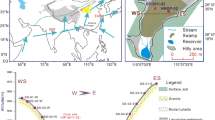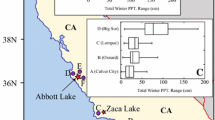Abstract
Continuous sediment cores H1 (11.0 m long) and H2 (8.5 m long), collected from Swan Lake, in the Nebraska Sandhills (USA), contain a sandy silt interval between overlying lake gyttja and underlying marsh peat. The marsh peat is a 3-m-thick layer in core H1 and a 1.5-m-thick layer in core H2, with basal ages of ca. 4790 and 4710 cal yr BP, respectively. Peat samples contain up to ~ 61% organic matter (OM) and lack CaCO3 and opal phases. Gyttja extends from 7.6 to 0 m in core H1 and from 6.6 to 0 m in core H2, with estimated basal ages of 3480 and 3530 cal yr BP, respectively. Gyttja samples contained stratigraphically fluctuating relative amounts of OM, precipitated CaCO3, biogenic (ostracod) CaCO3, and diagenetic mineralogical aggregates with CaCO3-opal-A-opal-CT-quartz or opal-A-quartz. OM content in the gyttja ranged from 15.1 to 32.1% and bulk CaCO3 content ranged from 13.5 to 34.6%. Mineralogical aggregates appeared after ~ 2630 cal yr BP in core H1 and after ~ 2590 cal yr BP in core H2, whereas ostracods were found only after ~ 1250 and ~ 1840 cal yr BP in the two cores, respectively. The discrepancy in the timing of ostracod occurrence may be related to environmental differences at the two locations, which are ~ 100 m apart. The sandy silt interval (0.4 m thick) between the peat and overlying gyttja accumulated between ~ 3700 and 3500 cal yr BP. It has relatively low OM (10.3–15.1%) and calcite content (0–6.1%) and no ostracods or mineralogical aggregates. The sandy silt interval possessed a high clastic content (~ 88%), with up to 3.2% Fe, 0.25% Ti, 108 ppm Rb, 105 ppm Zr, 65.5 ppm Cr, 36.6 ppm La, 10 ppm Th, and 2.6 ppm U. The clastic particles and associated metals were deposited by eolian processes during a dry and windy climate episode at the onset of the late Holocene in the Sandhills region.





Similar content being viewed by others
Change history
02 August 2022
A Correction to this paper has been published: https://doi.org/10.1007/s10933-022-00258-5
References
Barnes PW, Harrison AT (1982) Species distribution and community organization in a Nebraska Sandhills mixed prairie as influenced by plant/soil–water relationships. Oecologia 52:192–201
Belmecheri S, Namiotko T, Robert C, von Grafenstein U, Danielopol DL (2009) Climate controlled ostracod preservation in Lake Ohid (Albania, Macedonia). Palaeogeogr Palaeoclimatol Palaeoecol 277:236–245
Bleed A (1990) Groundwater. In: Bleed A, Flowerday C (eds) An Atlas of Sand Hills. University of Nebraska-Lincoln, Conservation and Survey Division, Resource Atlas No. 5A, pp 67–92
Bradley E, Rainwater F (1959) Geology and groundwater of the upper Niobrara River Basin, Nebraska and Wyoming. US Geol Surv Water Supply Paper 1368:44–49
Correns CW (1972) Behavior during weathering and rock alteration. In: Wedepohl KH, Correns CW, Shaw DM, Turekian KK, Zeman J (eds) Handbook of Geochemistry. Spring, New York, pp 33-G1
Dean WE, Megard RO (1993) Environmental of depositional of CaCO3 in Elk Lak, Minnesota. In: Bradbury JP, Dean WE (eds) Elk Lake, Minnesota: evidence for rapid climate change in North-Central United States. Geol Soc Am, Boulder
Exner ME, Spalding RF (1979) Evolution of contaminated ground water in Holt County, Nebraska. Water Resour Res 15:139–147
Facey JA, Apte SC, Mitrovic SM (2019) A review of the efect of trace metals on freshwater cyanobacterial growth and toxin production. Toxins 11:643
Goble RJ, Mason JA, Loope DB, Swinehart JB (2004) Optical and radiocarbon ages of stacked paleosols and dune sands in the Nebraska Sand Hills, USA. Quat Sci Rev 23:1173–1182
Goldsmith JR, Graf DL (1960) Subsolidus relations in the system CaCO3-MgCO3-MnCO3. J Geol 68:324–335
Gosselin DC, Nabelek PE, Peterman ZE, Sibray S (1997) A reconnaissance study of oxygen, hydrogen and strontium isotopes in geochemically diverse lakes, western Nebraska, USA. J Paleolimnol 17:51–65
Hassan KM (2014) Isotope geochemistry of Swan Lake Basin in the Nebraska Sandhills, USA: Large 13C enrichment in sediment-calcite records. Chem Erde 74:681–690
Hassan KM (2017) Mineralogical and geochemical signatures of silicified wood from the Petrified Forest, New Cairo, Egypt. Can Mineral 55:317–332
Hassan KM, Spalding RF (2001) Hydrogen isotope values in lacustrine kerogen. Chem Geol 175:713–721
Hassan KM, Swinehart JB, Spalding RF (1997) Evidence for Holocene environmental change from C/N ratios, and δ13C and 15N values in Swan Lake sediments, western Sand Hills, Nebraska. J Paleolimnol 18:121–130
Hassan KM (1998) Environmental changes within the last 5000 years from geochemical and stable isotopic compositions in sediment cores from Swan Lake, Nebraska, USA. Ph.D. dissertation, University of Nebraska, Lincoln
Hayford B, Baker D (2011) Lakes of the Nebraska Sandhills. Lakeline 31:26–30
Heiden KA, Holmes MA (1998) Grain size and significance of clay and clay-sized minerals in Eocene to Holocene sediments from sites 918 and 919 in the Irminger basin. In: Saunders AD, Larsen HC, Wise SW Jr (eds) Proceedings of the Ocean Drilling Program, Scientific Results, vol 152. Ocean Drilling Program, College Station, pp 39–49
Holmes JA (2001) Ostracoda. In: Smol JP, Birks HJB, Last WM (eds) Tracking environmental change using lake sediments, vol 4. Zoological Indicators. Kluwer, Dordrecht, pp 125–151
Jones B, Renaut R (2007) Microstructural changes accompanying the opal-A to opal-CT transition: new evidence from the siliceous sinters of Geysir, Haukadalur, Iceland. Sedimentolgy 54:921–948
Liu Q, Yang X (2018) Geochemical composition and provenance of aeolian sands in the Ordos Deserts, northern China. Geomorphology 318:354–374
Loope DB, Swinehart JB, Mason JP (1995) Dune-dammed paleovalleys of the Nebraska Sand Hills: intrinsic versus climatic controls on the accumulation of lake and marsh sediments. Geol Soc Am Bull 107:396–406
Loope DM (1995) Reconstruction of changes in salinity of Swan Lake in the Nebraska Sandhills based on diatoms in the Sediments. MS thesis, Northern Michigan University, Marquette, USA
Lynne BY, Campbell KA, Moore JN, Browne PRL (2005) Diagenesis of 1900-year-old siliceous sinter (opal-A to quartz) at Opal Mound Roosevelt Hot Springs, Utah, USA. Sediment Geol 179:249–278
Mann Whitney U Test Calculator (2017) Statistics Kingdom. http://www.statskingdom.com/170median_mann_whitney.html. Accessed 8 Apr 2022
Mason JP (1995) Influence of blocked drainages of paleoclimate record of the western Sandhills of Nebraska. MS thesis, University of Nebraska, Lincoln, USA
McCarraher DB (1977) Nebraska’s Sandhills lakes. Game and Parks Commission, Lincoln, Nebraska, USA
Miao X, Mason JP, Swinehart JB, Loope DB, Hanson PR, Goble RJ, Liu X (2007) A 10,000 year record of dune activity, dust storms, and severe drought in the central Great Plains. Geology 35:119–122
Nicholson BJ, Swinehart JB (2005) Evidence of Holocene climate change in a Nebraska Sandhills wetland. Gt Plains Res 15:45–67
Plant JA, Raiswell R (1983) Principles of environmental geochemistry. In: Thornton I (ed) Applied environmental geochemistry. Academic Press, London, pp 1–39
Rudnick RL, Gao S (2003) Composition of the continental crust. In: Rudnick RL (ed) and Holland HD, Turekian KK (exec eds), Treatise on geochemistry, vol 3, Elsevier-Pergamon, Oxford, pp 1–64
Schmieder J, Fritz SC, Grimm ES, Jacobs KC, Brown KJ, Swinehart JB, Porter SC (2012) Holocene variability in hydrology, vegetation, fire, and eolian activity in the Nebraska Sand Hills, USA. Holocene 23:515–527
Swinehart JB, Diffendal Jr, RF (1990) Geology of the pre-dune strata. In: Bleed A, Flowerday C (eds) An Atlas of the Sand Hills. University of Nebraska-Lincoln, Conservation and Survey Division, Resource Atlas No. 5A, pp 29–42
Swinehart JB (1990) Wind-blown deposits. In: Bleed A, Flowerday C (eds) An Atlas of Sand Hills. University of Nebraska-Lincoln, Conservation and Survey Division, Resource Atlas No. 5A, pp 43–56
Wedepohl KH (1995) The composition of the continental crust. Geochim Cosmochim Acta 59:1217–1232
Whitcomb RF (1989) Nebraska Sand Hills: the last prairie. In: Bragg TB, Stubbendieck J (eds) Proceedings of the eleventh North American Prairie Conference 33, University of Nebraska Printing, Lincoln, pp 57–69
Wilhite DA, Hubbard KG (1990) Climate. In: Bleed A, Flowerday C (eds) An Atlas of the Sand Hills. University of Nebraska-Lincoln, Conservation and Survey Division, Resource Atlas No. 5A, pp 17–28
Williams AS (1974) Late-glacial-postglacial vegetational history of the Pretty Lake region, Northeastern Indiana. US Geol Surv Surv Am, Professional Paper 686-B, pp 23
Winter TC (1986) Effect of ground-water recharge on configuration of water table beneath sand dunes and on seepage in lakes in the Sandhills of Nebraska. J Hydrol 86:221–237
Wright HE Jr, Almendinger J, Grüger J (1985) Pollen diagram from the Nebraska Sandhills and the age of the dunes. Quat Res 24:115–120
Yasuhara M, Hunt G, Breitburg D, Tsujimoto A, Katsuki K (2012) Human-induced marine ecological degradation: micropaleontological perspectives. Ecol Evol 2:3242–3268
Zlotnik VA, Burbach ME, Swinehart JB, Bennett DM, Fritz SC, Loope DB, Olaguera F (2007) Using direct-push methods for aquifer characterization in dune-lake environments of the Nebraska Sand Hills. Environ Eng Geosci 13:205–216
Acknowledgements
This research was funded by the Nebraska Research Initiative and the Water Center at the University of Nebraska-Lincoln. I acknowledge my former graduate committee members: R Spalding and J Swinehart helped with sample collecting, and D Harwood provided access to his laboratory. I thank MA Holmes for the XRD analysis and R Goble for the ICP-MS analysis. Both are at the UNL-Department of Earth and Atmospheric Sciences. Special thanks to Co-Editor-in-Chief M Brenner and thee anonymous reviewers who helped improve the manuscript.
Author information
Authors and Affiliations
Corresponding author
Additional information
Publisher's Note
Springer Nature remains neutral with regard to jurisdictional claims in published maps and institutional affiliations.
Supplementary Information
Below is the link to the electronic supplementary material.
10933_2022_250_MOESM1_ESM.pdf
Table S1 Average Āδ-values and C/Norganic ratios of Swan Lake sediments (± 1s). Data were compiled from Hassan et al. (1997), Hassan (1998), Hassan and Spalding (2001), and Hassan (2014) (PDF 94 KB)
10933_2022_250_MOESM2_ESM.pdf
Table S2 Composition of Swan Lake sediment cores H1 and H2, along with the upper continental crust (UCC) values of some elements from Rudnick and Gao (2003) (PDF 137 KB)
10933_2022_250_MOESM3_ESM.pdf
Plot of % OM and % organic carbon (OC) in Swan Lake sediments (n, number of samples; r, correlation coefficient). The OC data are from Hassan (1998) (PDF 27 KB)
Rights and permissions
Springer Nature or its licensor holds exclusive rights to this article under a publishing agreement with the author(s) or other rightsholder(s); author self-archiving of the accepted manuscript version of this article is solely governed by the terms of such publishing agreement and applicable law.
About this article
Cite this article
Hassan, K.M. Late Holocene climate change inferred from the lithology and chemical stratigraphy of sediment cores from Swan Lake, Nebraska Sandhills, USA. J Paleolimnol 68, 315–328 (2022). https://doi.org/10.1007/s10933-022-00250-z
Received:
Accepted:
Published:
Issue Date:
DOI: https://doi.org/10.1007/s10933-022-00250-z




